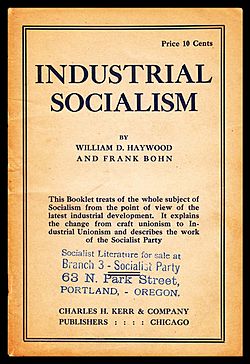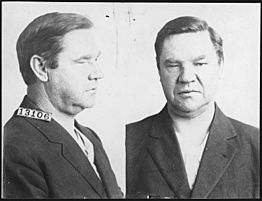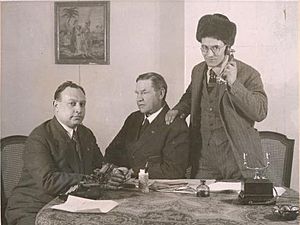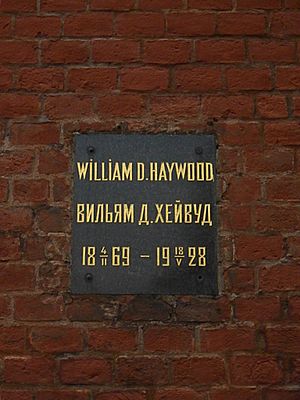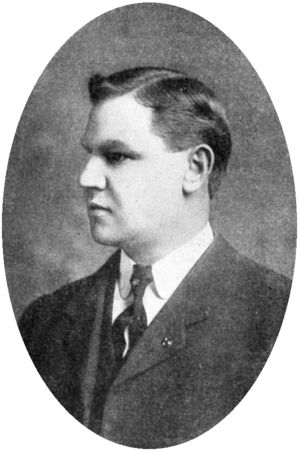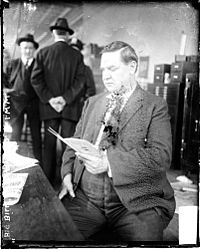Bill Haywood facts for kids
Quick facts for kids
Bill Haywood
|
|
|---|---|
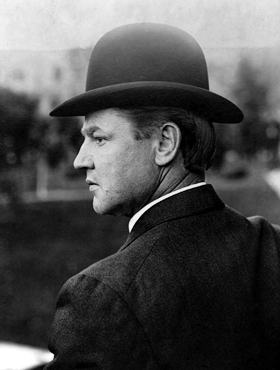 |
|
| 3rd and 5th General Secretary-Treasurer of the Industrial Workers of the World | |
| In office February 1918 – December 1918 |
|
| Preceded by | Fred Hardy (acting) |
| Succeeded by | Peter Stone |
| In office January 1915 – September 1917 |
|
| Preceded by | Vincent St. John |
| Succeeded by | Fred Hardy (acting) |
| Personal details | |
| Born |
William Richard Haywood
February 4, 1869 Salt Lake City, Utah Territory, U.S. |
| Died | May 18, 1928 (aged 59) Moscow, Russian SFSR, USSR |
| Resting place | Kremlin Wall Necropolis, Moscow |
| Nationality | American |
| Political party | Communist Socialist (until 1913) |
| Spouse |
Nevada Jane Minor
(m. 1889; |
| Children |
|
| Parents |
|
| Occupation | Labor leader and activist |
| Signature | |
William Dudley "Big Bill" Haywood (February 4, 1869 – May 18, 1928) was a very important American labor leader. He helped start and lead the Industrial Workers of the World (IWW). He was also part of the Socialist Party of America.
In the early 1900s, Haywood was involved in many big worker struggles. These included the Colorado Labor Wars and the 1912 Lawrence textile strike. He also helped with other textile strikes in Massachusetts and New Jersey.
Haywood believed in "industrial unionism". This idea meant that all workers in an industry should join one big union. It didn't matter what their specific job or skill was. This was different from other unions at the time, like the AFL. He thought workers of all backgrounds should unite. He also preferred direct actions, like strikes, over just political actions.
Haywood often faced legal challenges because of his strong views. In 1907, he was accused in the death of Frank Steunenberg, but he was found not guilty. Later, in 1918, he was one of many IWW members put in jail. This was for speaking out against war during a time called the First Red Scare. He was sentenced to twenty years in prison. In 1921, while waiting for an appeal, Haywood went to the Soviet Union. He lived there for the rest of his life.
Contents
- Bill Haywood's Life Story
- Growing Up and Early Work
- Joining the Western Federation of Miners
- Starting the Industrial Workers of the World
- Facing Legal Challenges
- The Trial and Its Outcome
- Leading the Lawrence Textile Strike
- Involvement with the Socialist Party
- Other Labor Work
- Espionage Trial and Flight
- Life in Soviet Russia
- His Death
- Bill Haywood's Ideas on Labor
- Works by Bill Haywood
- Images for kids
- See also
Bill Haywood's Life Story
Growing Up and Early Work
Bill Haywood was born in 1869 in Salt Lake City, Utah Territory. His father, who used to be a Pony Express rider, died when Bill was only three years old.
When Bill was nine, he hurt his right eye while making a slingshot. This injury left him permanently blind in that eye. He never got a fake eye, so in photos, he would turn his head to show his good eye. At 15, with little school education, Haywood started working in mines. He also worked briefly as a cowboy and a homesteader. By 1896, he was back to mining. Big events like the Haymarket Massacre in 1886 and the Pullman Strike in 1894 made him interested in helping workers.
Joining the Western Federation of Miners
In 1896, Ed Boyce, the president of the Western Federation of Miners (WFM), gave a speech at the silver mine where Haywood worked. Haywood was inspired and joined the WFM. This was the start of his work in the American labor movement. He quickly became active in the union. By 1900, he was on the union's main board. In 1902, he became the WFM's secretary-treasurer, which was the second most important job.
The next year, the WFM was involved in the Colorado Labor Wars. These were struggles in mining areas that led to the deaths of 33 workers. The WFM started strikes to get better conditions for more workers. When these strikes failed, Haywood became convinced that workers needed "One Big Union". This union would be organized by industry to get more support for worker struggles.
Starting the Industrial Workers of the World
In late 1904, several important labor activists met in Chicago. They planned a new kind of union. They wrote a statement and sent it out. Union members who agreed were invited to a meeting to start the new union, which became the Industrial Workers of the World (IWW).
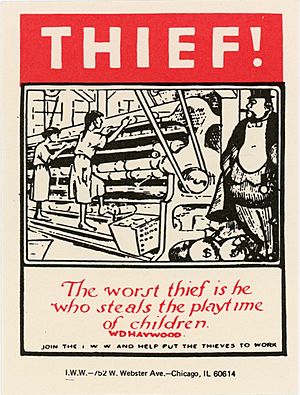
On June 27, 1905, Haywood spoke to a large crowd in Chicago. About 200 people were there, including socialists, anarchists, miners, and other workers. Haywood opened the IWW's first meeting with a powerful speech. He said they were there to unite workers to free them from "slavery of capitalism." He wanted workers to control how things were made and shared.
Other speakers at the meeting included Eugene V. Debs, a leader of the Socialist Party of America. Also there were Mary Harris "Mother" Jones, who organized for miners, and Lucy Parsons, another big labor organizer. After it started, the IWW became very active in helping workers.
Facing Legal Challenges
In 1906, Haywood and two other men, Moyer and Pettibone, were arrested in Denver, Colorado. They were accused of being involved in the death of Frank Steunenberg in Idaho. Even though they weren't in Idaho at the time, Idaho law said that people planning a crime were legally present. The police secretly moved them to Idaho.
Many union members felt this was like a kidnapping. The president of the AFL, Samuel Gompers, even asked his union to raise money for their legal help. However, the Supreme Court of the United States said the arrest was legal.
While in jail, Haywood ran for governor of Colorado in 1906. He received over 16,000 votes.
The Trial and Its Outcome
Haywood's trial started on May 9, 1907. Famous defense lawyer Clarence Darrow defended him. The main evidence against Haywood came from a man named Orchard, who admitted to the bombing. Darrow showed that Orchard had a troubled past and had even worked for both sides.
After nine hours, the jury decided on July 29 that Haywood was not guilty. Later, the charges against Moyer were dropped too.
Even with his strong beliefs, Haywood became famous after the trial. Eugene V. Debs called him "the Lincoln of Labor." Haywood was known for his direct way of speaking about big businesses. He often said, "The capitalist has no heart, but harpoon him in the pocketbook and you will draw blood."
Haywood left the WFM in 1908 and focused all his energy on the IWW.
Leading the Lawrence Textile Strike
Haywood was a key leader in the 1912 Lawrence textile strike in Lawrence, Massachusetts. On January 11, 1912, textile workers went on strike because their pay was cut. Soon, 20,000 workers were striking. Police were called, and things became violent. Local IWW leaders were jailed, accused in the death of a striker. Haywood and other organizers came to help lead the strike.
Haywood came up with a new idea: sending the hungry children of strikers to stay with caring families in other states. This was a first in American labor history. On February 10, 1912, the first group of children left Lawrence. They were welcomed with food and clothes in New York. Officials in Lawrence were shocked by this move.
On February 24, when more children tried to leave, police stopped them. Women and children were separated, and police used clubs. Many strikers and children were jailed. This caused a national outcry. Newspapers criticized the police. The incident led to a hearing in the United States Congress. Even President William Howard Taft paid attention. This public pressure made the mill owners agree to the workers' demands on March 12, ending the strike.
However, the IWW leaders who were jailed remained in prison. Haywood threatened another strike, saying, "Open the jail gates or we will close the mill gates." Finally, on November 26, the jailed leaders were found not guilty and released.
Involvement with the Socialist Party
For many years, Haywood was active in the Socialist Party of America. He believed in Marxist ideas. He campaigned for Debs in the 1908 United States presidential election. In 1912, he was elected to the Socialist Party's main committee.
However, Haywood and the IWW's strong methods, like strikes that sometimes led to violence, caused problems with more moderate Socialist Party leaders. Haywood focused on direct action, not just political votes. In 1913, he was removed from the Socialist Party committee. After this, Haywood and thousands of other IWW members left the Socialist Party.
Other Labor Work
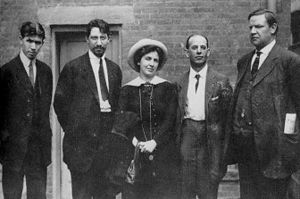
In 1913, Haywood was involved in the 1913 Paterson silk strike. About 1,850 strikers, including Haywood, were arrested. Despite a long struggle, the strike ended without success on July 28, 1913.
In 1915, Haywood became the General Secretary-Treasurer of the IWW. He held this job until 1917, and again in 1918.
Espionage Trial and Flight
Haywood and the IWW often had conflicts with the government. When World War I began, the government used the new Espionage Act of 1917 against them. On September 5, 1917, the government raided IWW offices. They arrested 165 IWW members, including Haywood. They were accused of trying to stop the military draft and cause problems in labor disputes.
In April 1918, Haywood and 100 other IWW members went on trial. The trial lasted five months, which was very long for that time. Haywood himself spoke for three days. All 101 people were found guilty. Haywood and fourteen others were sentenced to twenty years in prison.
Haywood could not get his conviction overturned. In 1921, while out of prison during an appeal, he left the country and went to the Russian SFSR. IWW officials were surprised by his decision.
Life in Soviet Russia
In Soviet Russia, Haywood became a labor advisor to Lenin's government. He worked in this role until 1923. Haywood also helped start a large industrial colony. People who visited Haywood in his small Moscow apartment later said he felt lonely and sad. He often said he wanted to return to the U.S. In 1926, he married a Russian woman. They had to use sign language to talk because they didn't speak each other's language.
His Death
On May 18, 1928, Haywood died in a Moscow hospital from a stroke. Half of his ashes were buried in the Kremlin Wall Necropolis. The other half were sent to Chicago and buried near the Haymarket Martyrs' Monument.
Bill Haywood's Ideas on Labor
What is Industrial Unionism?
Even before he joined the WFM, Haywood believed that the system for workers was unfair. He said the execution of the Haymarket leaders in 1887 changed his life. He saw men die in unsafe mines. He also found that only other miners supported him when he was hurt. When he heard Ed Boyce speak in 1896, he found radical unionism and liked it.
Haywood also didn't like the AFL. He thought their leaders didn't support strong worker actions enough. The AFL believed in "craft unionism". This meant workers were separated into unions based on their specific skills. The AFL often didn't organize workers who weren't skilled.
Haywood saw that a different kind of union was needed. He believed in "industrial unionism." This meant all workers in an industry, no matter their skill, should be in one union. For example, in 1888, when railroad engineers went on strike, the craft-organized firemen kept their engines running. This helped the companies break the strike.
Eugene V. Debs saw this problem too. He started the American Railway Union (ARU), which included all railroad workers. In 1894, the ARU joined a strike, and railroad traffic stopped. This showed how powerful industrial unionism could be. However, the strike was crushed by the government. The AFL refused to help the ARU. Haywood saw this as a betrayal. But he also saw the power of workers uniting across different jobs.
Haywood's belief in industrial unionism grew stronger after the WFM's defeat in the 1903–05 Cripple Creek strike. He felt it failed because there wasn't enough worker unity. Railroad workers, organized by craft, still moved ore from mines run by strike breakers. Haywood complained that this helped the mine owners. He believed the solution was for all workers to join the same union and act together. The WFM called the AFL the "American Separation of Labor."
Haywood's Revolutionary Ideas
Haywood's industrial unionism was more than just a way to strike better. He grew up as a working-class person and truly respected workers. He disliked employers who only gave orders to workers. After meeting Debs, Haywood also became interested in socialism. Haywood believed that "Labor produces all wealth; all wealth belongs to the producer thereof."
Haywood saw how the government often sided with businesses against workers. In 1899, during a strike, soldiers rounded up hundreds of union members. They put them in a dirty warehouse for a year without charges. One union leader was jailed for 17 years.
Haywood saw these harsh conditions as a "class warfare." In 1901, the WFM agreed that a "complete revolution of social and economic conditions" was needed for workers.
In Colorado, when the state passed an eight-hour workday law, the state supreme court said it was illegal. Even when voters approved it, the government ignored the results. Haywood felt that the system was unfair. He believed that lasting gains for workers could only come from changing the whole system. In 1905, Haywood joined with other socialists and unionists to create the IWW's idea of revolutionary industrial unionism. Haywood called this idea "socialism with its working clothes on."
Haywood preferred direct action, like strikes. He thought political action was useful only when it fit the situation. He could explain complex ideas simply. He summed up Karl Marx's ideas by saying, "If one man has a dollar he didn't work for, some other man worked for a dollar he didn't get." Haywood joked about his own injuries from mining and fights, saying, "I've never read Marx's Capital, but I have the marks of capital all over me."
When asked about private property, Haywood said that a capitalist's property was just "unpaid labor." He believed that all industries should be owned "by the workers."
Unity for All Workers
Unlike many other labor leaders of his time, Haywood believed that workers of all backgrounds should organize together. He said the IWW was "big enough to take in the black man, the white man; big enough to take in all nationalities."
Haywood criticized the U.S. government for trying to turn white workers against black workers during a conflict in 1899. He wrote that "race prejudice had been unknown among the miners" before this. In 1912, Haywood spoke at a convention for timber workers in Louisiana. At that time, meetings with both white and African American people were against the law. Haywood insisted that the white workers invite the African American workers to their meeting. He told them:
"You work in the same mills together. Sometimes a black man and a white man chop down the same tree together. You are meeting in a convention now to discuss the conditions under which you labor. Why not be sensible about this and call the Negroes into the Convention? If it is against the law, this is one time when the law should be broken."
Ignoring the law, the convention invited the African American workers. The group later voted to join the IWW.
Works by Bill Haywood
- Industrial Socialism With Frank Bohn. Chicago: Charles H. Kerr & Co., 1911.
- Bill Haywood's Book: The Autobiography of Big Bill Haywood. New York: International Publishers, 1929.
Images for kids
See also
 In Spanish: Bill Haywood para niños
In Spanish: Bill Haywood para niños


